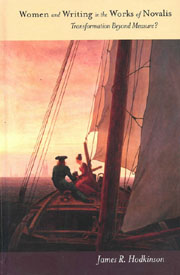Book contents
- Frontmatter
- Contents
- Acknowledgments
- Abbreviations of Major Primary Works Cited
- Typological Conventions in Novalis: Schriften
- Introduction
- 1 Writing in Context: Romanticism, Gender, and the Case of Novalis
- 2 Writing about Women, 1795–99
- 3 Esteem and the Epistolary: Hardenberg and Women of Letters
- 4 Music and the Manifold of Voices: The Subject and the Theory of Polyphony, 1797–99
- 5 From Music to Metamorphosis: Women's Role and Writing in Heinrich von Ofterdingen, 1798–1801
- 6 “Freyes Fabelthum”: The Poetic Construction of Gender in Hardenberg's Religious Writing
- Conclusion: Progression, Reaction, and Tension in Hardenberg's Gender Writing
- Works Consulted
- Index
3 - Esteem and the Epistolary: Hardenberg and Women of Letters
Published online by Cambridge University Press: 05 February 2013
- Frontmatter
- Contents
- Acknowledgments
- Abbreviations of Major Primary Works Cited
- Typological Conventions in Novalis: Schriften
- Introduction
- 1 Writing in Context: Romanticism, Gender, and the Case of Novalis
- 2 Writing about Women, 1795–99
- 3 Esteem and the Epistolary: Hardenberg and Women of Letters
- 4 Music and the Manifold of Voices: The Subject and the Theory of Polyphony, 1797–99
- 5 From Music to Metamorphosis: Women's Role and Writing in Heinrich von Ofterdingen, 1798–1801
- 6 “Freyes Fabelthum”: The Poetic Construction of Gender in Hardenberg's Religious Writing
- Conclusion: Progression, Reaction, and Tension in Hardenberg's Gender Writing
- Works Consulted
- Index
Summary
Gender and the Romantic Letter
IN WRITING ABOUT WOMEN, Hardenberg was not merely concerned with the creation of models of femininity in his autobiographical, scientific, and literary texts. He also pursued the practice of communicating with women through written language, in a form that we can still reflect upon today: he wrote them letters. This chapter looks at Hardenberg's epistolary exchanges with women. The rationale behind this survey is to perform a further test as to whether or not Hardenberg developed strategies in writing for dealing with women as literary individuals in their own right. We will begin by looking at the cultural-historical significance of letter writing in general, and in particular between the genders, around 1800. After looking briefly at a number of examples of letter exchanges between other male authors and women significant to them, the focus will shift to look at Hardenberg's letters to and from a number of women. We will evaluate the roles and attitudes adopted by both parties, asking whether or not Hardenberg opens a genuine channel of communication with women as intellectual and literary individuals, seeking their opinions and ideas on intellectual and cultural matters and encouraging their own literary productivity.
In reflecting upon letters in the final part of the eighteenth century, we must bear in mind that the nature and status of epistolary writing changed during this time. Whether implicitly or explicitly, the Romantics ceased treating letters simply as vessels for ideas or as mere opportunities for recording autobiographical data: increasingly letters took on a range of (at times stylized) literary qualities.
- Type
- Chapter
- Information
- Women and Writing in the Works of NovalisTransformation beyond Measure?, pp. 111 - 133Publisher: Boydell & BrewerPrint publication year: 2007



